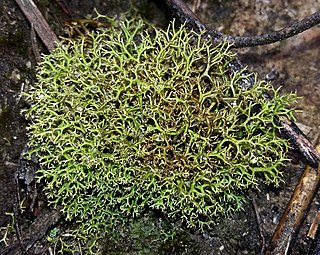Rimularia is a genus of lichenized fungi in the family Trapeliaceae. Rimularia was circumscribed by Finnish botanist William Nylander in 1868.
Lithographa is a genus of lichenized fungi in the family Xylographaceae. The genus was circumscribed in 1857 by Finnish botanist William Nylander, with Lithographa petraea assigned as the type species. This species is now known as Lithographa tesserata.
Heteromyces is a genus of lichenized fungi in the family Cladoniaceae. It is a monotypic genus, containing the single species Heteromyces rubescens. Both the genus and species were described by Swiss lichenologist Johannes Müller Argoviensis in 1889. The name Heteromyces was also used for a genus circumscribed by Lindsay S. Olive in 1957; this usage is illegitimate because of the prior usage of this name by Müller. Olive's concept of Heteromyces was renamed to Oliveonia by Marinus Anton Donk in 1958.
Gymnoderma is a genus of lichen-forming fungi in the family Cladoniaceae. It has three species. The genus was circumscribed by Finnish botanist William Nylander in 1860. Nylander assigned Gymnoderma coccocarpum as the type species in 1869; this species was originally collected from the Himalayas. It occurs throughout southeastern Asia.

Cladia is a genus of lichenized fungi in the family Cladoniaceae. Cladia species have a crustose primary thallus and a fruticose, secondary thallus, often referred to as pseudopodetium. The type species of the genus, Cladia aggregata, is widely distributed, occurring from South America, South Africa, Australasia and South-East Asia to southern Japan and India. Most of the other species are found in the Southern Hemisphere.
Speerschneidera is a single-species genus of lichen-forming fungi in the family Leprocaulaceae. The genus was circumscribed by Italian botanist Vittore Benedetto Antonio Trevisan de Saint-Léon in 1861, with Speerschneidera euploca as the type species. This lichen was originally described by Edward Tuckerman in 1858 as Physcia euploca. It is a crustose lichen found in the southern United States and Mexico.
Tremotylium is a genus of lichen-forming fungi in the family Graphidaceae. The genus was circumscribed by Finnish lichenologist William Nylander in 1865, but it was not published validly. He validated the genus and assigned T. angolense as the type species in 1868.

Schizopelte is a genus of lichen-forming fungi in the family Opegraphaceae. The genus was circumscribed by Theodor Magnus Fries in 1875. It was resurrected for use in 2011 by Damien Ertz and Anders Tehler, who published a phylogenetic study of the order Arthoniales. In addition to the type species, S. californica, they included a former Hubbsia species, a former Llimonaea species, and a species new to science in the resurrected Schizopelte.

Candelaria is a genus of lichen-forming fungi in the family Candelariaceae. The genus was circumscribed by Italian lichenologist Abramo Bartolommeo Massalongo in 1852.
Lichinodium is a genus of filamentous lichens. It is the only genus in the family Lichinodiaceae, itself the only member of the order Lichinodiales. Lichinodium has four species. Previously considered part of the class Lichinomycetes, molecular phylogenetic analysis revealed that Lichinodium represents a unique lineage in the Leotiomycetes—the first known group of lichen-forming fungi in this class.

Thelopsis is a genus of lichenized fungi in the family Stictidaceae. It was circumscribed by Finnish lichenologist William Nylander in 1855, with Thelopsis rubella as the type species.
Pseudopyrenula is a genus of lichen-forming fungi in the family Trypetheliaceae.

Dactylina is a genus of lichen-forming fungi in the family Parmeliaceae. The genus was circumscribed by Finnish botanist William Nylander in 1860, with Dactylina arctica assigned as the type species.

Parmotrema arnoldii, commonly known as the powdered ruffle lichen, is a widely distributed species of lichen in the family Parmeliaceae. It has been recorded from Africa, Asia, Europe, Oceania, Macaronesia, and North and South America.

Opegraphaceae is a family of lichen-forming and lichenicolous fungi in the order Arthoniales. It was originally proposed by German lichenologist Ernst Stizenberger in 1862. It fell into disuse, but was resurrected in a molecular phylogenetic study of the order Arthoniales published in 2010. It now includes taxa that were previously referred to the family Roccellaceae, its sister group.

Melaspilea is a genus of lichen-forming and lichenicolous fungi in the family Melaspileaceae. The genus was circumscribed by Finnish lichenologist William Nylander in 1857.
Brasilicia is a genus of leaf-dwelling lichens in the family Pilocarpaceae. It has 6 species. The genus was circumscribed in 2008 by lichenologists Robert Lücking, Klaus Kalb, and Emmanuël Sérusiaux, with B. brasiliensis assigned as the type species. The genus was originally circumscribed as monotypic; Edit Farkas transferred five species to Brasilicia from Bacidia in 2015.

Leprocaulaceae is a family of mostly lichen-forming fungi. It is the single family in the monotypic order Leprocaulales. Leprocaulaceae contains three genera and about 33 species.

Xylographaceae is a family of lichen-forming fungi in the order Baeomycetales. It contains four genera and 25 species.

Sporastatia is a genus of crustose lichens in the family Sporastatiaceae. It has four species. Sporastatia lichens are long-lived species that grow on siliceous or weakly calcareous rocks in arctic and alpine locales.











